Why Cuckmere Haven is of national importance
Posted: 30 May 2011 13:27
In 2008 the Environment Agency announced its intention to withdraw maintenance of the flood defences at Cuckmere Haven thereby threatening the future of the area's heritage.

I won't get bogged down too much in background details; you can read about it on the Cuckmere Pathfinder website at: http://cuckmerepathfinder.org.uk/.
However, I will draw your attention to the Heritage Aspects page of that website at: http://cuckmerepathfinder.org.uk/New-research/Heritage-assets.aspx where you can download two reports; both reports consider the archaeology stretching back to medieval times, not just 20th century defence structures.
The first report is the Stage 1 Heritage Asset Plan submitted by Oxford Archaeology in January 2011, following their survey of the landscape:
In overall terms...based on the coherence and time-depth qualities of the historic landscape the overall historic landscape is considered to be of National Importance. The historic building resource, including the upstanding military structures which dominate this group is considered to be of National Importance. While the true archaeological potential is unknown and always will be unless considerable below-ground investigation is undertaken, based on current knowledge and including the palaeo-archaeological resource, the archaeological resource is considered of National Importance. (Emphasis added)
The Stage 2 report by Casper Johnson, County Archaeologist at East Sussex County Council, identifies Option D: Maintain the existing defences as the only scenario that provides positive outcomes in the short, medium and long terms.
William Foot, in his report on Cuckmere Haven as part of the English Heritage Defence Areas Project identified the area as being of national importance:
The Cuckmere Haven defences provide a very good example of coastal anti-invasion defence in a location that has excellent public access. It is documented that this would have been a key point in the German invasion. The surviving combination of differing types of coastal defence works - pillboxes, anti-tank ditches, and anti-tank blocks - coupled with a ready appreciation of the defence components that have now been removed, make the area one of particular importance. The symbolism of this location, flanked by the iconic white cliffs, spells out well the message of Britain's defiance in 1940.
Cuckmere Haven - the Battlefield Beneath Your Feet
The Battlefield Beneath Your Feet is the title of a talk I currently (2011) give in which I try to make people aware of the fact that East Sussex was, and still is, a battlefield, even though few people readily accept this view when first introduced to it.
One key reason for this is that it's hard to visualise a battlefield when you can only see one or two isolated pillboxes in the landscape. We need to reinstate the missing pieces of the jigsaw for the picture to become clear. How do we do this? Documentary research, oral evidence and walking the ground.
Walking over a battlefield is essential to studying it, and here we already have one good reason for preserving Cuckmere Haven - you can't fully appreciate a battlefield if it's been destroyed or substantially altered.
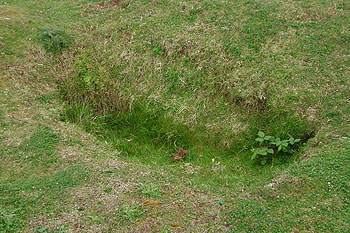
Cuckmere's landscape today would be recognisable to anyone stationed there in 1940 and its current condition allows us to understand and interpret it.
We can see the general lie of the land as it was back then and begin to understand why certain defences were constructed where they were.
But what of the missing defence works?
Actually, a lot of evidence still lies in the landscape - it's just a matter of recognising it for what it is.
The slit trench at right is a key example of earthworks that have hitherto been overlooked and are missing from the picture.
Ongoing research is starting to reveal the hidden evidence on the battlefield - and there is much we don't yet know that the people, documents and landscape can still tell us.
Reconstructing the battlefield
The video gives you a tour of part of the Cuckmere Haven battlefield that I've reconstructed in 3D.
The model was constructed from both Allied and German sources and demonstrates how there was a co-ordinated system of defence works here at Cuckmere Haven.
Once you see the demolished structures reinstated, you can see how the surviving concrete defences fit into the battle plan and also how the landscape itself becomes a weapon.
However, if we can digitally reconstruct the battlefield in its entirety, does it matter if parts of the area are flooded and the evidence destroyed? Yes, it does!
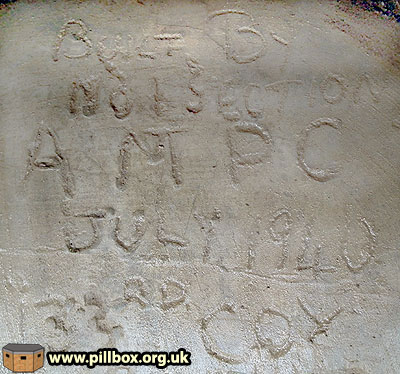
The battlefield is still talking to us
I've visited Cuckmere Haven many times and walked and cycled many, many miles up, down and across it. Almost every visit causes me to see something new in the landscape that increases my understanding of the World War Two battlefield.
Just a week ago, I located evidence of two pillboxes and some unrecorded graffiti (seen at right) and the plethora of graffiti and artefacts in the line of dragon's teeth by the river mouth provide some wonderful evidence of the men who constructed these defences.
We can see their names, their unit identity and their sense of humour all written into the concrete.
Put this activity into the context of the period; invasion was coming. The Germans had rampaged across Europe sweeping all resistance aside and were seemingly capable of superhuman feats.
Yet, against this backdrop of dark clouds, the humour of the British Tommy is still there.
If this graffiti were prehistoric cave-painting, it would be preserved without question - it would be old enough to be significant. Do we have reason to think that historians and archaeologists a thousand years from now will not be interested in 1940 doodling?
If these low-lying structures are inundated, all of this wonderful evidence could be lost and the battlefield will stop giving up its secrets.
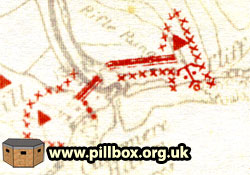
But is Cuckmere Haven really a battlefield?
Yes! Look at all the effort put into the defence works here. The Cuckmere defences were still being added to into 1942.
The Germans regarded this as a battlefield; the Befestigungskarte extract at right shows the lengths to which the Germans went to plot the defences of the UK.
Why did they do this? Because they were intending to do battle right here. We know that had Operation Sealion been launched, Cuckmere Haven would have been assaulted.
Cuckmere Haven actually did come under enemy fire throughout the war. A German U-Boat shelled Exceat in 1940 and numerous air attacks have been documented in the area. A naval mine somehow made its way up the Cuckmere River in 1943 before being defused at Alfriston. In 1944, the Luftwaffe bombed the decoy here.
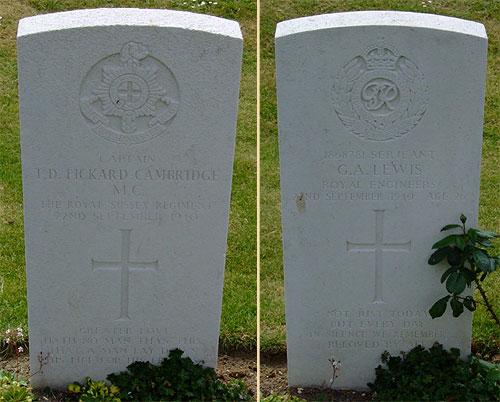
Men were killed and wounded on this battlefield; four tragically lost their lives laying mines in September 1940, two of whom are buried in Seaford Cemetery, as seen at left.
In later years another two men were lost after straying into a minefield on the eastern beach; a Canadian who assisted the surviving members of the group out of the danger area was recommended for a gallantry award.
It's not known if he ever received the recognition he deserved; he was himself killed by enemy action a few days later at Cuckmere Haven.
In 1944, another act of gallantry at Cuckmere Haven was acknowledged with the award of the George Medal to a British officer.
An Allied fighter crash-landed here in the middle of the war, stopping just short of a minefield.
Defended positions, enemy attack, casualties, acts of heroism, aircraft crashing - this is a battlefield!
What makes the battlefield of Cuckmere Haven unique?

If you examine the battlefield throughout the rest of the UK, then on the face of it, the defences at Cuckmere Haven would not appear to have been unique; every exposed area of coastline had some sort of defence system.
We know that the Germans would have landed at other places in East Sussex and Kent, but something that Cuckmere Haven retains is a relatively undisturbed landscape and a good proportion of upstanding defence works.
The area at Pevensey known as The Crumbles was a highly defended, vulnerable invasion beach. However, a good many features were totally destroyed when the Sovereign Harbour was built, meaning that we can no longer interpret this part of the battlefield by walking it - it's gone.
But we need to look beyond the 1940-41 invasion scare. While Cuckmere Haven originally had all of the major types of defence work (slit trenches, pillboxes, minefields, anti-tank ditches, anti-tank guns, machine guns, barbed wire, anti-tank cubes, scaffolding), the story doesn't end with the threat of invasion receding.
We have ongoing activity through into 1944. We have the anti-raid period of 1941-44 when the threat of small-scale German commando raids became the focus of the defences.
We have the lighting decoy of 1942 (part of which is seen at right) that replicated the lights of Newhaven.
We have all manner of training exercises from 1940 onwards. On the periphery of the valley we have gunnery ranges and an airfield. We have the submarine cable station at Exceat that formed part of the communications network for the invasion of Normandy in 1944. Cuckmere Haven was the western-most boundary of the main corridor through which the V1 flying bombs passed on their way towards London.
The continued and documented use of the area in conjunction with the known events, human stories, surviving evidence and almost undisturbed landscape make Cuckmere Haven a very special case. And don't forget that the area also has First World War and Napoleonic military heritage.

What we stand to lose
Part of all this World War Two heritage (not to mention the older archaeology) will be lost if we don't start to appreciate what we have and what we can preserve for future generations.
The full extent and significance of the military defences have only in recent years become apparent. We've only just rediscovered this battlefield and yet we're in danger of losing it again - but this time for ever. It may seem that as the events of 1939-45 are still within living memory, it's not so important.
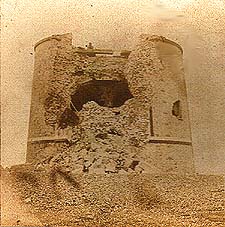
The Martello Towers precedent
The Martello Towers were, for the Victorians, eyesores of an invasion scare within living memory and of little value - what if they had demolished them all? If they had, then we today would be wondering how they looked and rueing their loss, or else be indifferent because insufficient evidence would survive to make them "interesting" to all but the devoted researcher.
We have an interesting parallel with the WW2 defences here; in 1936, the Department of Works undertook the first steps towards realising the importance of Martello Towers:
They are of some interest as forming a systematic scheme for the defence...of the coast...and they may legitimately be considered as the lineal descendants of the Henry VIII castles...They may also be reckoned as the ancestors of the "Pill-boxes" of 1915-18, many of which still survive in close juxtaposition of their forerunners on the east coast.
The siting of the Martello Towers in relation to the natural features of the coast and of the ground inland, and their close grouping are interesting features of the system.
This is important - not only is this report acknowledging that the towers are of historical value, but also that they are part of a system (they also note gun batteries and an earthwork redoubt) that ties in with the landscape.
The towers are also linked to previous and subsequent defence works - the reference to WW1 pillboxes is very interesting. The Cuckmere defences can be added to the lineage of fortification.
This foresight did not save a couple of towers, but Tower 4 at Folkestone was saved from demolition in 1959 simply because it would have broken an intact numbering sequence (Towers 1-9) and would have set a precedent to permit others to be demolished too.
A dangerous precedent?
All of this makes Cuckmere Haven of national importance in another way - if we allow this heritage to be lost, what precedent does it set for other important areas in the country to be lost?
Will future generations thank us for missing an opportunity to save evidence of one of the darkest and most significant events in our recent history? If the answer to that question is yes, then we may as well take our sledgehammers to Pevensey Castle, the Brighton Pavilion and the British Library.
Thousands of people visit the Cuckmere Valley each year; I think that everyone can benefit more if we preserve the site and add to their enjoyment of the landscape by being able to tell them what happened here and letting them see it. We can't tell the story if we deliberately neglect the preservation of the largest and most important piece of evidence we have.
I wholeheartedly agree with the experts quoted above when they say that Cuckmere Haven is of national importance, but not just on account of its undoubted valuable heritage; the preservation of other battlefields may depend on the next battle to be fought on this one.
- Pete

Email:
Blog Latest

Bishopstone reveals its pillbox secrets
18 October 2021

Pillbox or Observation Post?
10 June 2020

Uncovering the hidden secrets of a pillbox
8 June 2019

Review of 2018
31 December 2018

Wartime Christmas in East Sussex (2)
24 December 2018
Jargon-buster
Anti-tank ditch
Ditch designed to hinder movement of tanks and AFVs. Ditches could be entirely artificial or existing ditches or natural features such as rivers, might be dredged, shaped and revetted to improve their effectiveness.
Befestigungskarte
Fortifications map compiled by German Intelligence from aerial photographs during 1940-41 in preparation for Operation Sealion. Defence works were plotted using a system of red symbols.
Cubes
Anti-tanks blocks, popularly known as dragon's teeth. Not to be confused with smaller blocks known as pimples, cubes can be upwards of 1m square. Many examples in Sussex have apexes or chamfered edges, leading to them being incorrectly recorded as coffins.
Defence Areas Project
A study based on 67 areas identified from the Defence of Britain Project database as good examples of areas where significant portions the defences still survived, the study of which resulted in William Foot's Beaches, fields, streets and hills.
Demolition
Term applied to a structure scheduled for demolition or already demolished. Walls and small buildings might be taken down to clear fields of fire or impede enemy passage by destroying a bridge. Some demolitions were not intended to be carried out until after invasion had begun, for example, certain bridges or road craters (pipe mines).

Martello Tower
Napoleonic gun towers built along the vulnerable coasts of SE England 1805-1812. Most that still stood in 1940 were occupied for military defence, as artillery observation posts or by the Royal Observer Corps. Many towers had a concrete roof added for extra protection.
Pillbox
Generic term for a hardened field defensive structure usually constructed from concrete and/or masonry. Pillboxes were built in numerous types and variants depending on location and role.
Scaffolding
Two designs of obstacle were constructed from scaffolding; Z0 anti-boat and Z1 anti-tank scaffolding. The framework was deemed the best anti-tank obstacle for beaches, providing a tank didn't have a good run up. Erected from about 1941, scaffolding was very labour-intensive and used an enormous amount of steel.
Sealion
(German Seel÷we) - Operation Sealion was the code name for the German plan for the invasion of Britain.
Slit trench
Small, narrow trench designed to provide protection against shrapnel and other battlefield hazards. Technically distinct from a weapon pit (which was intended soley as a defensive position) slit trenches were also used as defence works.
This site is copyright © Peter Hibbs 2006 - 2024. All rights reserved.
Hibbs, Peter Why Cuckmere Haven is of national importance (2024) Available at: http://www.pillbox.org.uk/blog/216684/ Accessed: 27 July 2024
The information on this website is intended solely to describe the ongoing research activity of The Defence of East Sussex Project; it is not comprehensive or properly presented. It is therefore NOT suitable as a basis for producing derivative works or surveys!